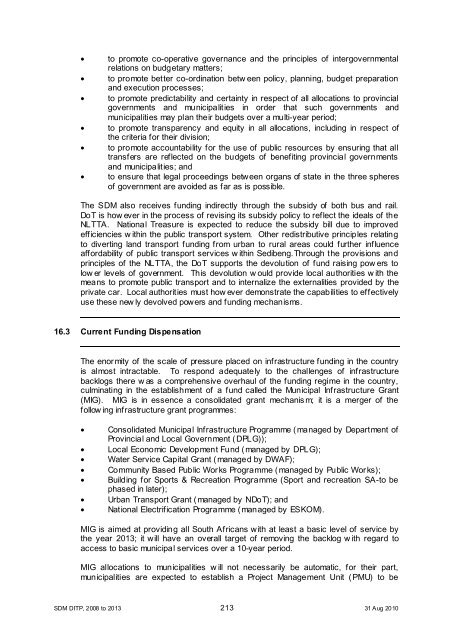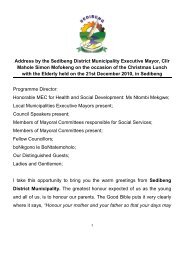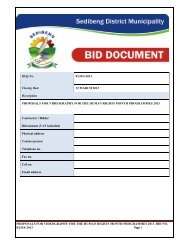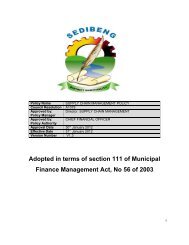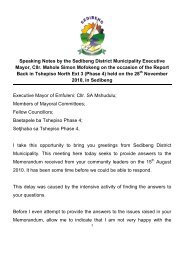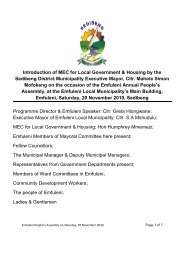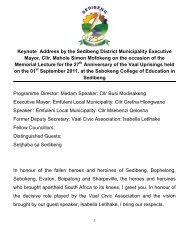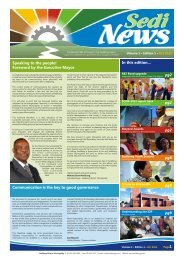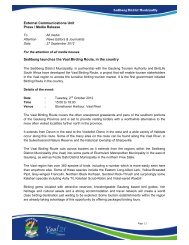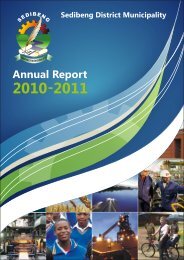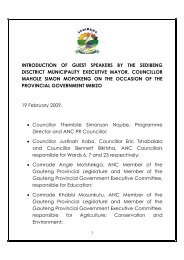Chapter 11 - Sedibeng District Municipality
Chapter 11 - Sedibeng District Municipality
Chapter 11 - Sedibeng District Municipality
Create successful ePaper yourself
Turn your PDF publications into a flip-book with our unique Google optimized e-Paper software.
• to promote co-operative governance and the principles of intergovernmental<br />
relations on budgetary matters;<br />
• to promote better co-ordination betw een policy, planning, budget preparation<br />
and execution processes;<br />
• to promote predictability and certainty in respect of all allocations to provincial<br />
governments and municipalities in order that such governments and<br />
municipalities may plan their budgets over a multi-year period;<br />
• to promote transparency and equity in all allocations, including in respect of<br />
the criteria for their division;<br />
• to promote accountability for the use of public resources by ensuring that all<br />
transfers are reflected on the budgets of benefiting provincial governments<br />
and municipalities; and<br />
• to ensure that legal proceedings between organs of state in the three spheres<br />
of government are avoided as far as is possible.<br />
The SDM also receives funding indirectly through the subsidy of both bus and rail.<br />
DoT is how ever in the process of revising its subsidy policy to reflect the ideals of the<br />
NLTTA. National Treasure is expected to reduce the subsidy bill due to improved<br />
efficiencies w ithin the public transport system. Other redistributive principles relating<br />
to diverting land transport funding from urban to rural areas could further influence<br />
affordability of public transport services w ithin <strong>Sedibeng</strong>.Through the provisions and<br />
principles of the NLTTA, the DoT supports the devolution of fund raising pow ers to<br />
low er levels of government. This devolution w ould provide local authorities w ith the<br />
means to promote public transport and to internalize the externalities provided by the<br />
private car. Local authorities must how ever demonstrate the capabilities to effectively<br />
use these new ly devolved powers and funding mechanisms.<br />
16.3 Current Funding Dispensation<br />
The enormity of the scale of pressure placed on infrastructure funding in the country<br />
is almost intractable. To respond adequately to the challenges of infrastructure<br />
backlogs there w as a comprehensive overhaul of the funding regime in the country,<br />
culminating in the establishment of a fund called the Municipal Infrastructure Grant<br />
(MIG). MIG is in essence a consolidated grant mechanis m; it is a merger of the<br />
follow ing infrastructure grant programmes:<br />
• Consolidated Municipal Infrastructure Programme (managed by Department of<br />
Provincial and Local Government (DPLG));<br />
• Local Economic Development Fund (managed by DPLG);<br />
• Water Service Capital Grant (managed by DWAF);<br />
• Community Based Public Works Programme (managed by Public Works);<br />
• Building for Sports & Recreation Programme (Sport and recreation SA-to be<br />
phased in later);<br />
• Urban Transport Grant (managed by NDoT); and<br />
• National Electrification Programme (managed by ESKOM).<br />
MIG is aimed at providing all South Africans with at least a basic level of service by<br />
the year 2013; it will have an overall target of removing the backlog w ith regard to<br />
access to basic municipal services over a 10-year period.<br />
MIG allocations to municipalities w ill not necessarily be automatic, for their part,<br />
municipalities are expected to establish a Project Management Unit (PMU) to be<br />
SDM DITP, 2008 to 2013 213 31 Aug 2010


